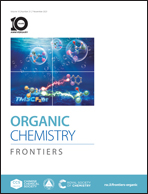Theoretical studies to predict the utility of diazo esters in their reactions with 1,4-quinones: experimental validation via a visible light driven metal free process†
Abstract
We report here theoretical and experimental studies that revealed two distinct modes of reactivity of 1,4-quinones (benzoquinone [BQ], 2-methyl benzoquinone [MBQ], naphthoquinone [NQ], and anthraquinone [AQ]) with electronically different alkyl-2-diazoalkylnoates and aryl diazo acetates (electron acceptor–electron donor), methyl diazo acetates (electron acceptor) and dialkyl-2-diazomalonate (electron acceptor–electron acceptor) under blue LEDs. Depending on the substrate–reactant combination, the reaction either happens at the C![[double bond, length as m-dash]](https://www.rsc.org/images/entities/char_e001.gif) C region or the C
C region or the C![[double bond, length as m-dash]](https://www.rsc.org/images/entities/char_e001.gif) O region of 1,4-quinones to provide a diverse variety of aryl vinyl ethers, spiro epoxides, and cyclopropanated and CH-alkylated quinones. Computational studies based on density functional theory calculations predicted the reaction outcomes which were later corroborated via experimentation.
O region of 1,4-quinones to provide a diverse variety of aryl vinyl ethers, spiro epoxides, and cyclopropanated and CH-alkylated quinones. Computational studies based on density functional theory calculations predicted the reaction outcomes which were later corroborated via experimentation.



 Please wait while we load your content...
Please wait while we load your content...